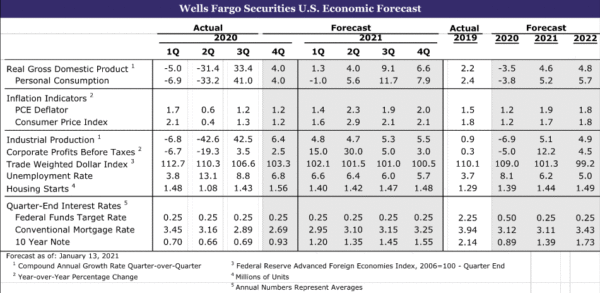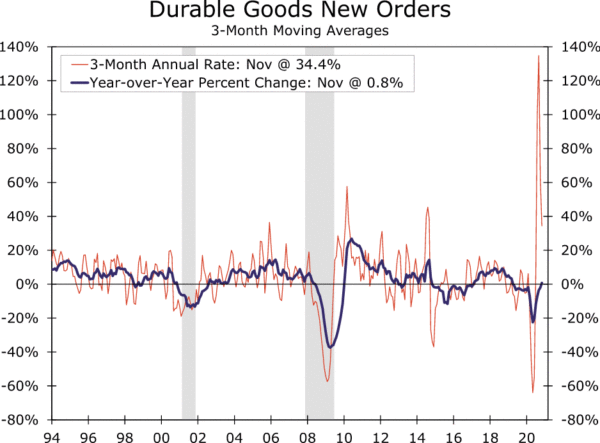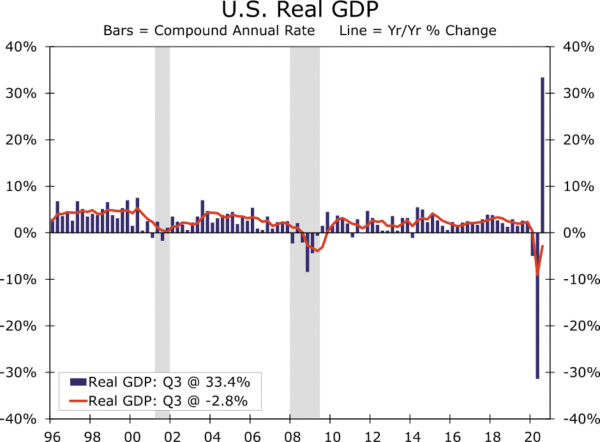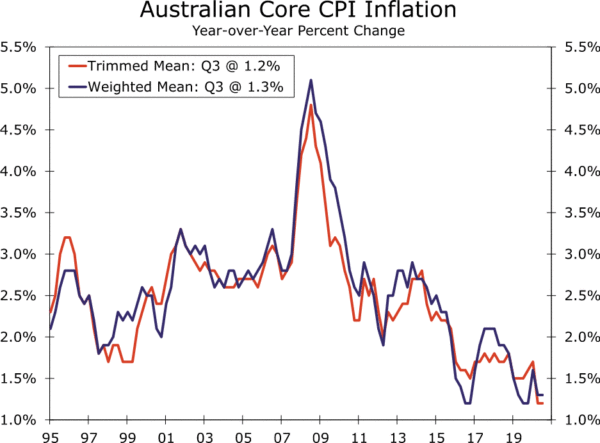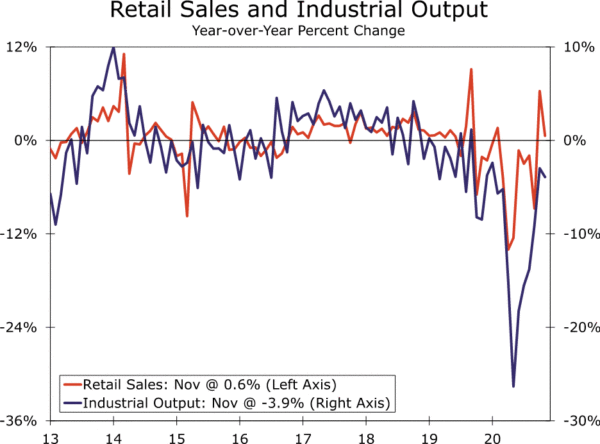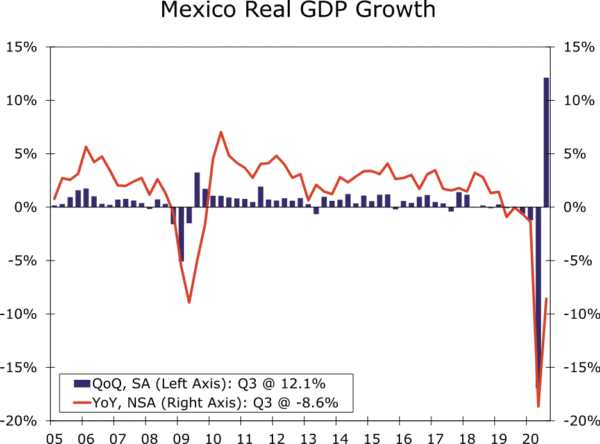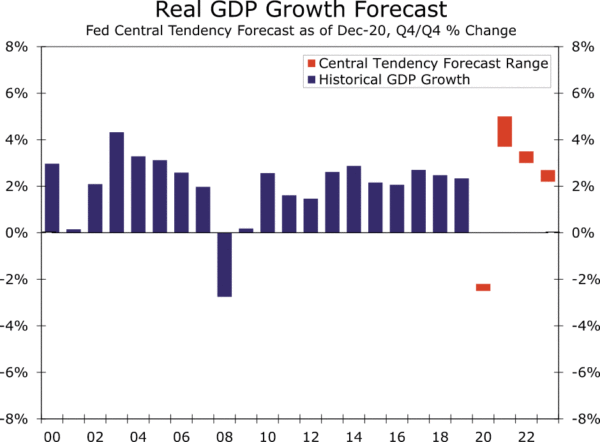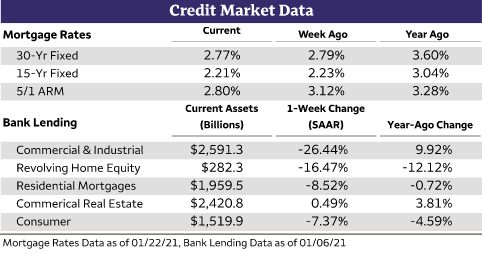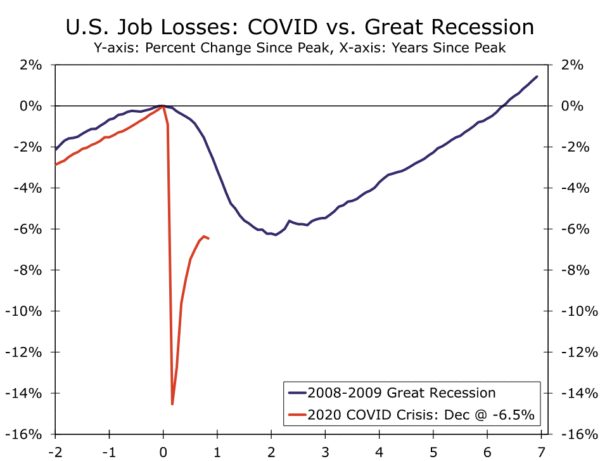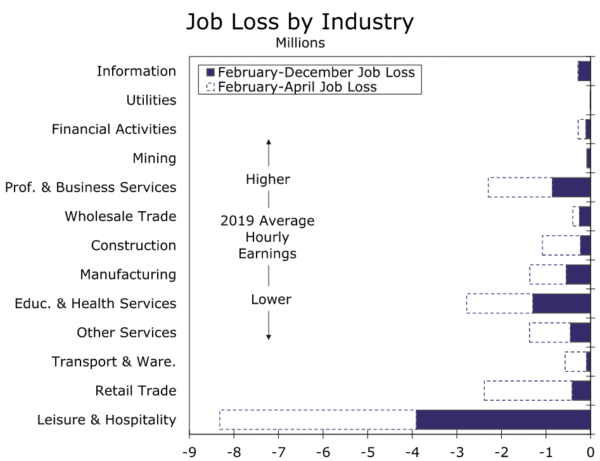U.S. Review
Housing Remains at the Forefront of the Recovery
- Housing starts jumped 5.8% during December. Single-family starts soared 12%, while multifamily starts dropped 13.6%. Total starts are running at a 1.67 million-unit pace, the strongest pace since 2006. Existing home sales rose 0.7% to a 6.76 million-unit pace in December. Mortgage applications for purchase are up 14.7% over the year as of January 15.
- The NAHB Housing Market Index fell to 83 in January. Builder confidence remains exceptionally high, but the index has slipped in recent months alongside rising material prices and the latest COVID surge. Initial jobless claims fell to 900K during the week ended January 16. Despite the drop, new filings remain elevated, which means another negative print for payrolls in January is possible.
Global Review
Mixed Fortunes for the Global Economy
- This past week saw some reports showing mixed fortunes for key international economies. China reported another solid GDP increase in Q4, while for full-year 2020 GDP rose 2.3%, the only major global economy to enjoy positive growth last year. Elsewhere, Japan and Mexico appear to be experiencing a steady rather than especially strong rebound, while Eurozone PMI surveys hint at a renewed contraction across the region in late 2020 and early 2021.
- For now, central banks are sitting on the sidelines. The European Central Bank held monetary policy steady and, with regard to its asset purchases, said that it might not use its full envelope of asset purchases, but equally that its purchase program could be re-calibrated. The Bank of Canada kept policy unchanged, though hinted at an eventual tapering in bond purchases as confidence in the economic recovery improves, while the Bank of Japan held monetary policy unchanged at its meeting this week.
U.S. Review
Housing Remains at the Forefront of the Recovery
The housing market was the primary focus of attention this week. Over the course of 2020, housing emerged as one of just a few bright spots in an otherwise horrible year. Driven by record-low mortgage rates and shifting preferences for more livable space to accommodate virtual activities, home sales, housing starts and builder confidence quickly recovered from the deep losses experienced during the lockdown months last spring.
With the calendar now turned to 2021, the housing market appears to be cooling off a bit. Still, even with some moderation, most indicators of housing activity are running at a robust pace. During December, existing home sales beat expectations and rose 0.7%. The 6.76 million-unit pace of sales is over 22% above prior-year levels. What’s more, mortgage applications for purchase continue to trend higher, which means the pace of home sales is likely to remain elevated over the coming months. Purchase application increased 2.7% during the week of January 15 and are now up 14.7% over the past year.
Similarly, residential construction continues to heat up as builders move to satiate rising buyer demand. Total housing starts jumped 5.8% to a 1.67 million-unit pace in December, which is the strongest pace since 2006. The monthly gain was owed entirely to a robust 12% surge in single-family starts. Single-family starts are now up 27.8% over the year. By contrast, multifamily construction continues to pull back somewhat, alongside rising rental vacancy rates and shifting preferences for single-family homes. Multifamily starts declined 13.6% in December and are down 38.7% year-over-year.
Considering the momentum in the single-family sector, it comes as little surprise that builder confidence remains exceptionally high. The NAHB Housing Market Index dropped two points to 83 during January, but is still only slightly below the high-water mark of 90 reached in November. Several factors appear to have pulled down builder confidence from on high. For one, the re-emergence of COVID is likely keeping potential buyers at home, which helps explain the recent dropoff in the prospective buyer traffic sub-component. Supply-side challenges, namely surging lumber prices, which can significantly drive up the cost of building a home, are also creating some challenges.
Overall, we expect housing to remain at the forefront of the recovery. Meanwhile, the labor market is still clearly far from returning to prior peak levels. New filings for unemployment benefits fell the week ended January 16; however, at 900K, initial claims remain highly elevated. The drop in claims is a welcome development, but another negative print for payrolls in January remains within the realm of possibility.
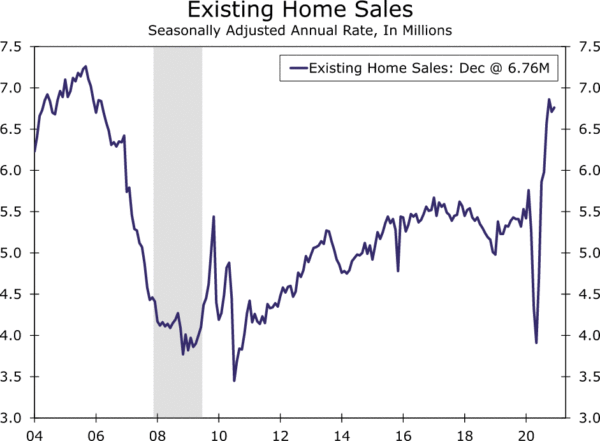
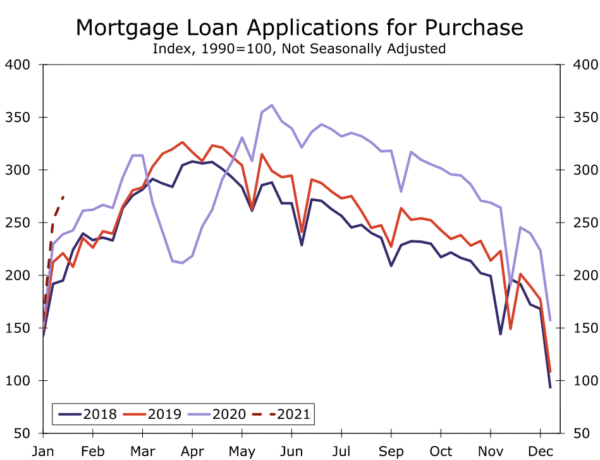
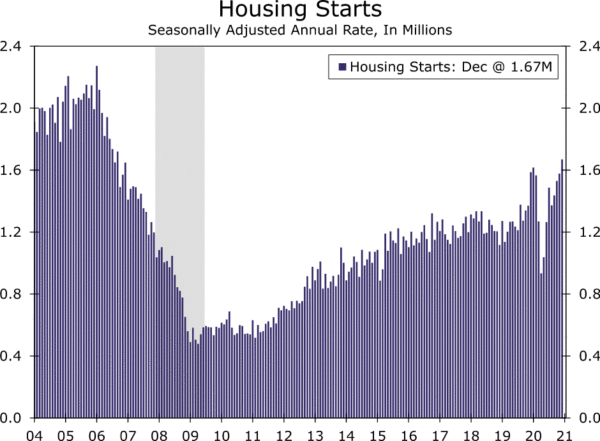 U.S. Outlook
U.S. Outlook
Consumer Confidence • Tuesday
Consumer spending ended 2020 on a soft note with retail sales falling in the final three months of the year. Thanks to robust spending in the summer and fall months, holiday sales managed an 8.7% year-over-year increase, but it was clear that amid rising case counts the consumer was hunkering down. This was also evident in the consumer confidence figures, which came in at 88.6 in December, well below the 97.0 that had been expected by the consensus.
With case counts continuing to rise in the first half of January and the unrest in Washington, how are consumers holding up in the new year? On Tuesday, we will get a better sense of that when the Conference Board’s preliminary report for January consumer confidence hits the wire. The University of Michigan’s consumer sentiment index prints on Friday.
Previous: 88.6 Wells Fargo: 89.5 Consensus: 89.1
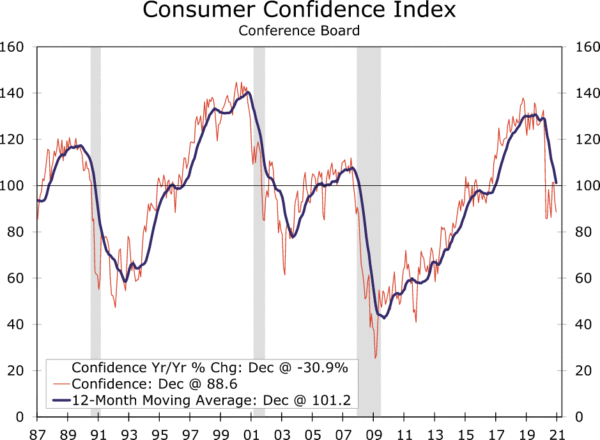 Durable Goods Orders • Wednesday
Durable Goods Orders • Wednesday
While the service sector has continued to be buffeted by social distancing requirements and a resurgent virus, the manufacturing sector has continued to rebound nicely. This dynamic is evident in the purchasing manager surveys. The ISM services index rebounded to 57.2 in December, but that is still a few points shy of the manufacturing ISM, which sits proudly at 60.7.
We already know from the soft retail sales figures that service sector activity was soft in December, but how is the hard data holding up for manufacturing? On Wednesday of next week, December durable goods orders will give the latest indication of how manufacturing is faring heading into the start of 2021.
Previous: 1.0% (Month over month) Wells Fargo: 0.9% Consensus: 1.0%
GDP • Thursday
In the third quarter, the economy expanded at a 33.4% annualized rate. This was the reopening quarter after lockdowns caused growth to crater in the prior quarter. On Thursday of next week, we will get the first estimate of how the economy fared in the final quarter of the year.
The low base effects and the reopening of the economy that flattered third quarter growth will not be in play, so a sharp slowdown is in order. It is just a question of how much. Our bet is that GDP grew at only a 4.0% clip as consumers slowed their pace of spending and the rebound in business fixed investment likely lost some steam as well.
A significantly better or worse outturn could obviously have implications for growth in 2021, as it sets the base level for output in the new year. We will also be watching inventory investment. The net change in inventories will likely be positive for the first time in over a year.
Previous: 33.4% (CAGR) Wells Fargo: 4.0% Consensus: 4.4%
International Review
China’s Robust Recovery Continues
The latest economic figures point to an ongoing robust pace of recovery for China’s economy. Q4 GDP rose 2.6% quarter-over-quarter (not annualized), broadly as expected, though with upward revisions to prior quarters the annual pace of GDP growth firmed more than forecast to 6.5% year-over-year. The secondary sector, which includes manufacturing and has led the recovery so far, firmed moderately to 6.8% year-over-year. Meanwhile, growth in the tertiary sector, which includes services, quickened more noticeably to 6.7%.
The fourth quarter also ended with reasonable momentum as December industrial output unexpectedly firmed to 7.3% year-over-year, although retail sales growth did slow unexpectedly to 4.6%. For 2020 overall, considering the large shock from COVID in the first quarter in particular, the economy grew an impressive 2.3% for the full year. With the economy also showing decent momentum into year-end, we forecast strong growth for 2021 and expect China’s GDP to rise by 9.4% this year.
Bank of Canada Holds Monetary Policy Steady
The Bank of Canada held policy steady at this week’s monetary policy meeting, while also offering a more hopeful outlook on future growth prospects. The central bank kept its overnight rate at 0.25% and reiterated that interest rates should remain low through until 2023. The central bank said it would continue its quantitative easing program at the current purchase program of around C$4 billion per week. However, the central bank also said as confidence in the recovery improves, the pace of purchases will be adjusted as required—a hint toward an eventual tapering of bond purchases.
Speaking of the recovery, the Bank of Canada’s updated forecasts sees slower growth in the near-term, with Q1-2021 GDP expected to fall at a 2.5% quarterly annualized rate. However, as vaccines become more widely available the central bank expects a more solid rebound over time. For full-year 2021, the Bank of Canada expects growth of 4.0%, little changed from its previous projection. For full-year 2022, the central bank predicts GDP growth of 4.8%, much stronger than the previous forecast for an increase of 3.7%.
Eurozone Economy Stumbles in Early 2021
Eurozone economic trends have been mixed during the past few months, and this week’s key economic data showed a renewed stumble for the region’s economy in early 2021. Given the renewed spread of COVID cases, several Eurozone governments have re-imposed restrictions in recent months, weighing on activity. That pushed the Eurozone services PMI back below the breakeven 50 level in late 2020 and, after a moderate gain to 46.4 in December, the services PMI declined again in January to 45.0. Activity in the manufacturing sector has not been quite as soft, although the Eurozone January manufacturing PMI also eased to 54.7.
Given the recent confidence surveys and activity data, Eurozone GDP appears on course for a renewed contraction in the near-term. Indeed, the latest consensus forecast anticipates a Q4 GDP decline of 2.4% quarter-over-quarter, while there is likely some downside risk to the consensus Q1 GDP forecast of 0.4%. That said, the economy has not been so weak as to prompt further action from the European Central Bank (ECB) so far, with the ECB opting to keep monetary policy unchanged at this week’s meeting.
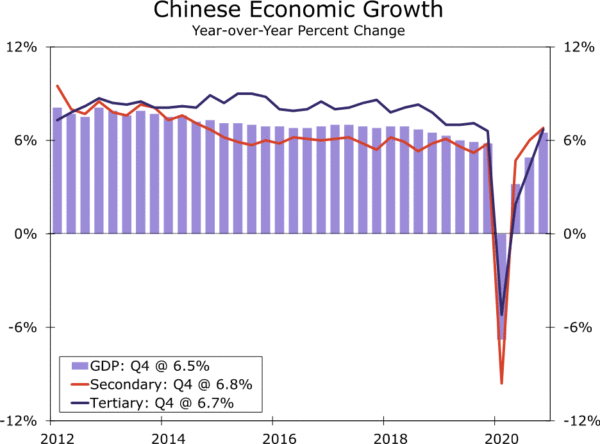
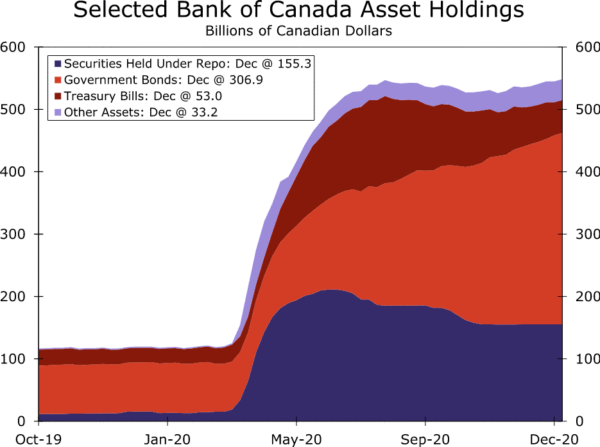
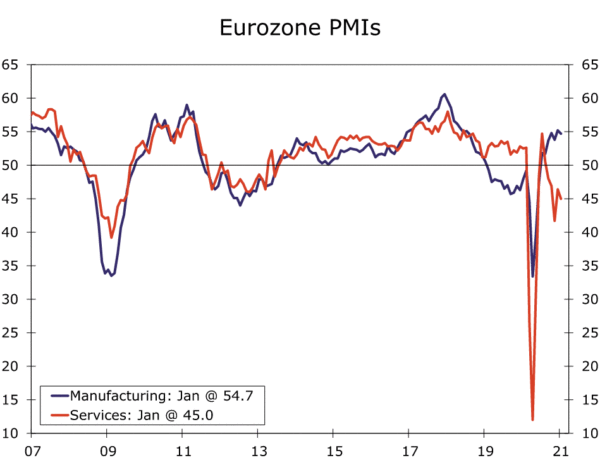 International OutlookAustralia CPI • Wednesday
International OutlookAustralia CPI • Wednesday
Q4 CPI inflation figures from Australia next week should indicate that price pressure remain very benign. After rising a modest 0.7% year-over-year in Q3, headline CPI inflation is forecast to rise by the same 0.7% in Q4. It is not only headline CPI trends that are benign, with core inflation measures also subdued. For Q4, the weighted median CPI is expected to slow to just 1.2% year-over-year, and the trimmed mean CPI is expected to slow to 1.1%.
Subdued inflation is one factor that prompted a further round of monetary easing from the RBA in late 2020, as the central bank cut its policy interest rate to 0.10% and announced additional bond purchases. Still despite low inflation we do not expect further easing from the RBA given some signs of improvement in the economy. Employment rose in all three months during Q4-2020, while confidence surveys have generally shown improving trends in recent months as well.
Previous: 0.7% Consensus: 0.7% (Year-over-Year
Japan Retail Sales • Thursday
Following a sharp rebound in GDP during the third quarter, next week’s data are likely to show a slowing in momentum for Japan’s economy heading into the end of 2020. The consensus forecast is for December retail sales to decline 0.9% month-over-month, after a fall of 2.1% in November. A December decline would be the third in the past four months, and would leave retail sales essentially flat for the Q4 as a whole compared to Q3. December industrial output is also expected to fall 1.5% month-over-month, following a decline in November.
The initial surge in growth that was supported by fiscal stimulus and the economy’s reopening has started to wane, with the renewed spread of the COVID virus prompting some restrictions on activity. The consensus forecast is for Q4 GDP growth to slow to around 1.0% quarter-over-quarter, and for an outright decline in GDP in Q1. That has not prompted a monetary policy response so far however, with the Bank of Japan opting to hold monetary policy steady at its January meeting.
Previous: -2.1% Consensus: -0.9% (Month-over-Month)
Mexico GDP • Friday
Mexico’s economy is rebounding from its sharp decline in early 2020, and while that recovery is likely to have continued into the fourth quarter, the momentum of the recovery has probably slowed. The consensus forecast is for Q4 GDP to fall 6.7% year-over-year, less than the 8.6% decline seen in the third quarter. While that outcome should be consistent with positive quarterly growth on a sequential basis, Q4 GDP will likely show a sharp slowdown from the 12.1% quarter-over-quarter jump seen in Q3.
Monthly economic figures point to the continued recovery in the fourth quarter. Industrial production has risen on a sequential basis for five months in a row through November, and retail sales have risen for five of the past six months through October. Next week also sees the release of November retail sales, which is likely to show a monthly increase, and the November economic activity index, which is expected to rise by 0.6% month-over-month.
Previous: 8.6% Consensus: 6.7% (Year-over-Year)
Interest Rate Watch
Don’t Expect Much from the FOMC Next Week
The Federal Open Market Committee (FOMC) holds its first meeting of 2021 on January 26-27, but don’t expect the committee to announce any major policy changes. Yes, the economy has lost a fair amount of momentum in recent months as renewed restrictions to slow the spread of COVID have been put in place in many states. However, the Summary of Economic Projections (SEP) that the FOMC released at the conclusion of its last meeting in December showed that most committee members generally remain upbeat about the economic outlook later this year. As shown in the graph below, most committee members forecast that U.S. real GDP will grow roughly 4% to 5% this year. This view is predicated on the assumption that the economy fully reopens later this year as vaccines become widely deployed. Furthermore, President Biden has proposed another fiscal relief package. Although the full $1.9 trillion package likely will not survive the congressional approval process, some portion likely will be legislated. More fiscal relief would reduce some downside risk to the economy in coming months.
Therefore, the FOMC is likely in watch-and-wait mode at present. The committee clearly will not be raising rates anytime soon, and it will continue to purchase Treasury securities and mortgage-backed securities at its current monthly pace of $80 billion and $40 billion, respectively, for the foreseeable future, which should help to prevent a sharp rise in long-term interest rates. Chairman Powell may be asked in his post-meeting press conference about the committee’s plans to eventually dial back the pace of asset purchases, but we expect him to refrain from discussing a specific timeline. In our view, the FOMC is likely to err on the side of providing “too much” policy accommodation rather than “too little” until signs emerge that the U.S. economy has truly entered a self-sustaining recovery. Downside risks to the economy will remain elevated until the pandemic finally recedes for good. For further reading about our views regarding Fed policy, see “January Flashlight for the FOMC Blackout Period”.
Topic of the Week
What Are the Prospects for Another COVID Relief Deal under President Biden?
The Democratic sweep in the Georgia Senate elections has given Democrats unified control of the House of Representatives, the Senate and the White House for the first time since 2009-2010. This in turn has created an opening for the most sweeping economic policy changes driven by the Democrats in a decade. However, the window for change is about as tight as is conceivable due to the razor-thin majorities in both chambers. In the House, the Democratic majority is just a few seats, while the Senate is tied 50-50, with the tie broken by Vice President Kamala Harris. It will be a challenging political landscape for the new administration to navigate, as even small defections from either flank of the Democratic party could sink new legislation.
Shortly before his inauguration, Joe Biden released a 19-page outline for a roughly $1.9 trillion “American Rescue Plan.” The full details of the plan can be found here. The proposal looks a lot like previous COVID relief packages, but with more sizable numbers and with some additional progressive policy additions. Biden’s plan would send out additional $1,400 checks on top of the $600 payments that were made under the COVID relief bill passed in December 2020. For unemployment insurance, the plan would increase the current $300 a week federal top-up to $400 and extend these payments, as well as the pandemic unemployment insurance programs created in the CARES Act, through September 2021. Additional household income support would come from increasing the child tax credit for 2021 to $3,000 from $2,000 and making it fully refundable, making the Earned Income Tax Credit more generous and extending the current 15% increase in Supplemental Nutrition Assistance Program (SNAP) benefits through September 2021.
We view President Biden’s proposal as an opening bid and not necessarily an outline that will be translated into law verbatim. But, the 19-page outline is fairly detailed for an opening bid, and it firmly signals that another COVID relief deal will be a Day One legislative priority for the Biden administration. Our expectation is that a deal will eventually be struck, probably in March, but that the final legislation will be much smaller than what is in Biden’s proposal, and more along the lines of the $900 billion package that was enacted in December.
For further reading, see our recent special report “What Are the Prospects for Another COVID Relief Deal under President Biden?”




